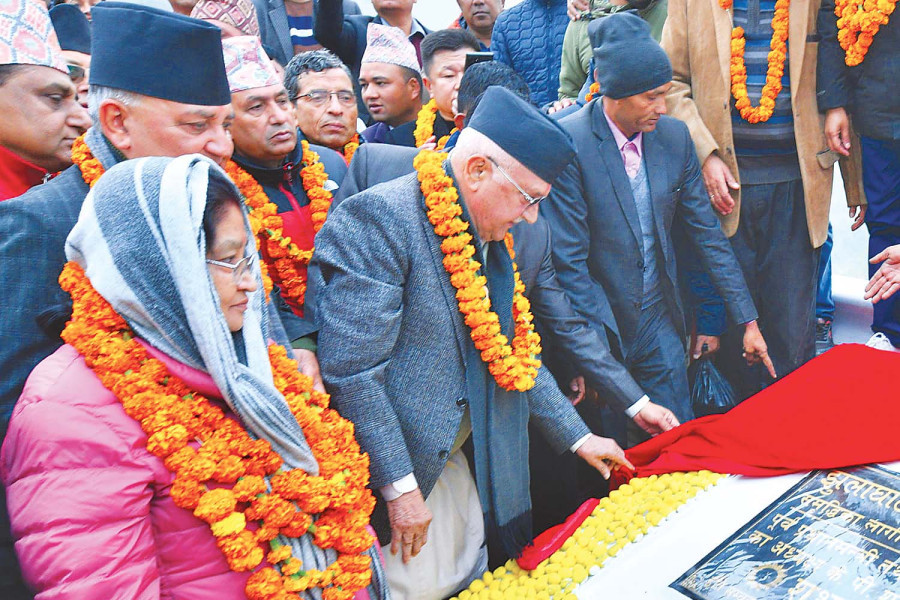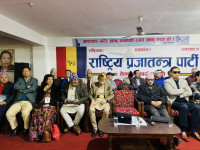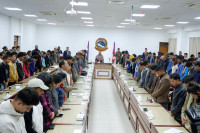Politics
UML too hits the campaign trail with an eye on 2027 vote
As ruling parties are relatively quiet, opposition forces are trying to make themselves seen and boost their prospects.
Binod Ghimire
The constitution mandates the holding of general elections every five years. Snap polls come only when all constitutional options of government formation fail.
The Pushpa Kamal Dahal government, elected after the parliamentary vote held last year, is about to complete a year in office. That leaves four years for the next federal and provincial elections. But Nepali political parties already seem to be itching to head to the polls.
Neither the first party in the federal parliament, Nepali Congress, nor the second, CPN-UML, leads the government. It’s rather the third, Dahal’s CPN (Maoist Centre), which steers the administration from Singha Durbar.
Last year’s polls elected a hung parliament. The pre-poll alliance of the Congress, the Maoists and some fringe forces, and Dahal’s manoeuvrings after the results were out, propelled the leader who once waged a decade-long insurgency to the seat of power.
Dahal so far enjoys the backing of the Congress, the Janata Samajbadi Party, the CPN (Unified Socialist), the Janamat Party and the Nagarik Unmukti Party. As the Maoist Centre, the Congress and the Unified Socialist remain committed to the tripartite deal to lead the government on a rotation basis, there is no immediate sign of snap polls.
Rabi Lamichhane’s promising outfit, Rastriya Swatantra Party, still licking its wounds after being ejected from Singha Durbar following a brief stint in government, aims to win a bigger share of parliamentary seats in 2027, in what it dubs ‘Mission Chaurasi’.
Every other party, new and old ones alike, is now aiming for that opportunity. This is why they are already campaigning to consolidate their vote-share in the next elections.
The Swatantra Party held a three-day joint meeting of its central committee and the parliamentary party in Jaleshwar of Mahottari. Choosing Jaleshwar was a strategic decision for the party, in order to convey the message that Madhesh is its priority now. Just two weeks ago, the party went door to door thanking voters.
The day the fourth-largest party concluded its Madhesh meet, the UML started its own hill-centric campaign. Party chair and former prime minister KP Sharma Oli inaugurated the 19-day “Jhulaghat-Chiwa Bhanjyang March for Prosperity” in Baitadi district. The Oli-led march aims at interacting with the local communities in 26 districts connected by Mid-Hill Highway, also called Pushpa Lal Highway, named after the Nepal Communist Party’s founder.
“This campaign is definitely a part of Mission 27 [the general elections will be held in 2027]. However, that is not the only goal,” Bishnu Rimal, the party’s deputy general secretary, told the Post. “We want to listen to the people, get in touch with them.”
While announcing the march on November 8, the party announced that it was more than a political campaign, and targeted at giving a message of development and national unity. “These days development activities are gradually being concentrated in the hills and rural areas. But then more and more people are migrating to the Tarai and urban areas,” Pradeep Gyawali, the party’s deputy general secretary, said. “We need to stop this [migration] trend, or development activities up in the hills will be meaningless.”
It was the UML government that started building the Mid-Hill Highway. This year marks the diamond jubilee of the communist party established by Pushpa Lal Shrestha.
Addressing the inaugural event in Jhulaghat, Baitadi on Thursday, Oli said his is the only party the general public can rely on. This journey across the hills will be an opportunity to interact with the general people at the grassroots and conduct an on-site study of local issues, Oli said. “The knowledge gathered from such events will help in policy-making.”
Dozens of party leaders and cadres are on the march. Oli will be leading the campaign covering 1,771 kilometres. Rajendra Gautam, chief of the party’s publicity department, said they are interacting with all communities along the way.
“This is not a mass demonstration. We are not focusing on gathering people. Yet thousands of people turn up wherever we go,” Gautam told the Post. “We are excited and encouraged by such an enthusiastic public response.”
From Baitadi, the march stopped at Dadeldhura before reaching Mangalsen in Achham district. Oli addressed the gatherings in all the places.
Gautam said the party interacted with people at Rakam in Dailekh district on Sunday. “Today’s [Sunday] gathering in Rakam was one of the largest the place had ever seen,” Gautam claimed. The party leadership will address a gathering in Surkhet on Monday before moving to Jajarkot. The march will conclude in Chiwa Bhanjyang of Panchthar district on December 18.
“The event has re-energised both the party and the people,” said Rimal.
The opposition party had organised a grassroots campaign before the bypolls in April. However, the drive seemed to have little effect in the face of an alliance of the ruling parties. The UML fared poorly in the by-elections.




 16.12°C Kathmandu
16.12°C Kathmandu















